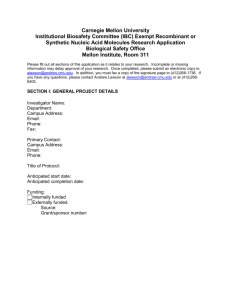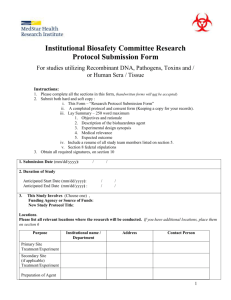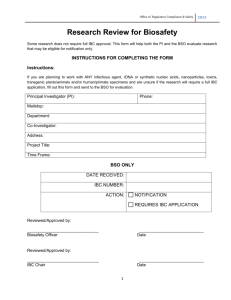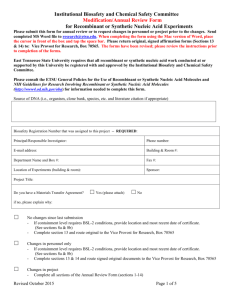Biosafety Registration (BRF)
advertisement
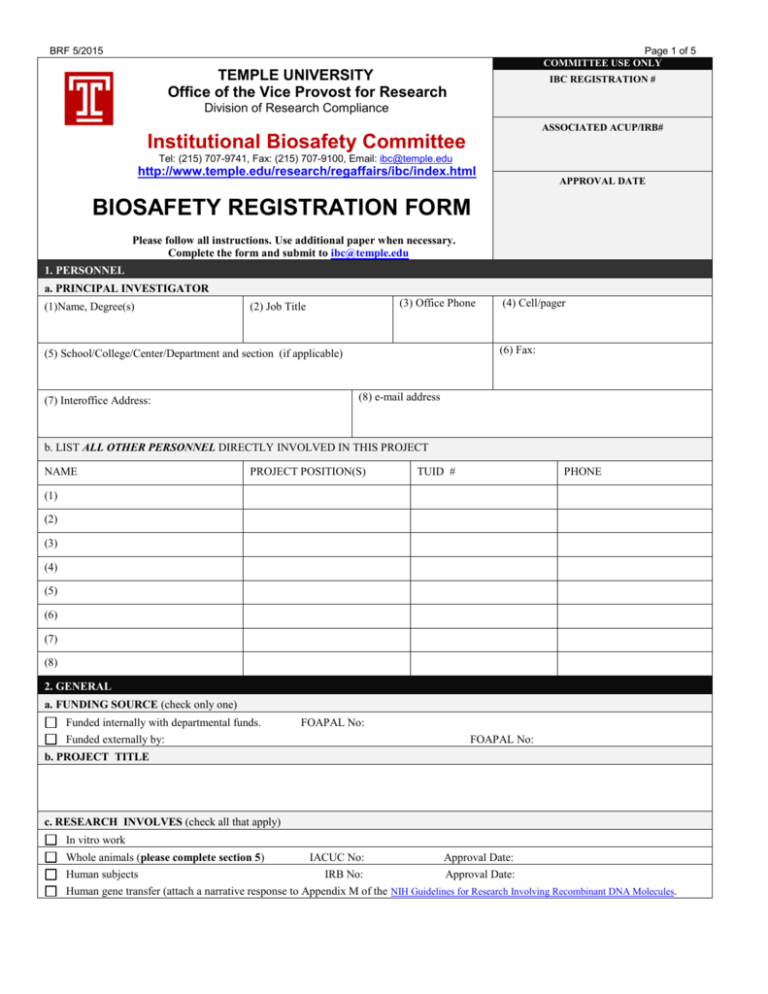
BRF 5/2015 Page 1 of 5 COMMITTEE USE ONLY TEMPLE UNIVERSITY Office of the Vice Provost for Research IBC REGISTRATION # Division of Research Compliance ASSOCIATED ACUP/IRB# Institutional Biosafety Committee Tel: (215) 707-9741, Fax: (215) 707-9100, Email: ibc@temple.edu http://www.temple.edu/research/regaffairs/ibc/index.html APPROVAL DATE BIOSAFETY REGISTRATION FORM Please follow all instructions. Use additional paper when necessary. Complete the form and submit to ibc@temple.edu 1. PERSONNEL a. PRINCIPAL INVESTIGATOR (1)Name, Degree(s) (3) Office Phone (2) Job Title (4) Cell/pager (6) Fax: (5) School/College/Center/Department and section (if applicable) (8) e-mail address (7) Interoffice Address: b. LIST ALL OTHER PERSONNEL DIRECTLY INVOLVED IN THIS PROJECT NAME PROJECT POSITION(S) TUID # PHONE (1) (2) (3) (4) (5) (6) (7) (8) 2. GENERAL a. FUNDING SOURCE (check only one) Funded internally with departmental funds. Funded externally by: FOAPAL No: FOAPAL No: b. PROJECT TITLE c. RESEARCH INVOLVES (check all that apply) In vitro work Whole animals (please complete section 5) IACUC No: Approval Date: Human subjects IRB No: Approval Date: Human gene transfer (attach a narrative response to Appendix M of the NIH Guidelines for Research Involving Recombinant DNA Molecules. BRF 5/2015 Page 2 of 5 d. BRIEF ABSTRACT (Please attach a copy of specific aims and experimental design of your grant/research project) e. NAMES OF MICROORGANISMS (VIRUSES, BACTERIA, etc.) AND/OR HAZARDOUS DRUGS USED 3. RECOMBINANT DNA OR SYNTHETIC NUCLEIC ACIDS a. RECOMBINANT INSERT (TRANSGENE) (1) Specify the source of the DNA/RNA sequences (gene of interest, including genus, species, gene name(s) and abbreviations(s)): (2) If the recombinant DNA or synthetic nucleic acids contains viral DNA, does the insert represent more than 2/3 of the viral genome? (3) Will a deliberate attempt be made to obtain expression of the foreign gene encoded in the recombinant DNA? (4) What is the biological activity of the gene product or sequence inserted? N/A No Yes No Yes b. VECTOR (1) Specify the plasmid for propagation of the recombinant DNA or synthetic nucleic acids (include genus, species and parent strain, Provide the name of the plasmid and genetic map): (2) Is the host strain prokaryotic (for example, use E. Coli to produce vector)? If yes, complete the following. (a) Is it a plasmid, phage, or other? If other, specify: No Yes (b) Is a packaging cell line or transfected plasmid with helper functions required? If yes, specify the expression system (for example, use four plasmids expression system for lentiviral vector): No Yes Is the host strain eukaryotic (for example, use adenoviral vector)? If yes, complete the following. No Yes (3) (a) Is the strain a virus, clone viral genome, pro-virus, or other? If other, specify: (b) Can it infect human cells? No Yes (c) Is a helper virus required? No Yes, specify: BRF 5/2015 Page 3 of 5 (d) If a viral vector, what % of the viral genome remains? N/A or % c. TARGET RECIPIENT (1) Specify the target recipient of the vector-recombinant DNA or vector-synthetic nucleic acids combination (indicate species or cell lines): d. SYNTHETIC NUCLEIC ACIDS (1) Research with genetically modified virus or a vector derived solely by synthetic nucleic acid techniques No Yes (2) Synthetic nucleic acids that can replicate or generate nucleic acids in any living cell No Yes (3) Synthetic nucleic acids are designed to integrate into DNA No Yes (4) Synthetic nucleic acids produce a toxin that is lethal for vertebrates at an LD50 of <100 ng/kg body wt No Yes (5) Clinical Research involves the transfer of synthetic nucleic acids (> 100 nucleotides) into human subject No Yes e. NIH GUIDELINES (1) Identify the section of the NIH guidelines that apply to this project (check that all apply, see NIH Guidelines for Research Involving Recombinant DNA Molecules): III-A Experiments that Require Institutional Biosafety Committee Approval (IBC), RAC Review, and NIH Director Approval Before Initiation III-A-1 Major Actions under the NIH Guidelines- Experiments that Require Institutional Biosafety Committee Approval, RAC Review, and NIH Director Approval Before Initiation III-B Experiments That Require NIH/OBA and Institutional Biosafety Committee Approval Before Initiation III-B-1 Experiments Involving the Cloning of Toxin Molecules with LD50 of Less than 100 ng per kg Body Weight III-B-2 Experiments that have been Approved (under Section III-A-1-a) as Major Actions under the NIH Guidelines III-C Experiments that Require IBC and Institutional Review Board Approvals (IRB) and RAC Review Before Research Participant Enrollment III-C-1 Experiments Involving the Deliberate Transfer of Recombinant or Synthetic Nucleic Acids, or DNA or RNA Derived from Recombinant or Synthetic Nucleic Acids, into One or More Human Research Participants III-D Experiments that Require IBC Approval Before Initiation (see Appendix B of NIH guidelines to identify your risk group). III-D-1 Experiments Using Risk Group (RG) 2, RG 3, RG 4, or Restricted Agents as Host-Vector Systems III-D-2 Experiments in Which DNA From RG 2, RG 3, RG 4, or Restricted Agents is Cloned into Nonpathogenic Prokaryotic or Lower Eukaryotic Host-Vector Systems III-D-3 Experiments Involving the Use of Infectious DNA or RNA Viruses or Defective DNA or RNA Viruses in the Presence of Helper Virus in Tissue Culture Systems III-D-4 Experiments Involving Whole Animals III-D-5 Experiments Involving Whole Plants III-D-6 Experiments Involving More than 10 Liters of Culture III-D-7 Experiments Involving Influenza Viruses III-E Experiments that Require IBC Notice Simultaneous with Initiation III E-1 Experiments Involving the Formation of Recombinant or Synthetic Nucleic Acid Molecules Containing No More than Two-Thirds of the Genome of any Eukaryotic Virus III-E-2 Experiments Involving Whole Plants III-E-3 Experiments Involving Transgenic Rodents III-F Exempt Experiments, please use biosafety level 1 registration form 4. SAFETY AND PROTECTION a. SOP SOP # b. BIOHAZARDS/ HAZARDOUS DRUGS (1) (2) is followed. Submit a new SOP if there is any deviation from the standard SOP. BUILDING ROOM Biosafety Level QTY/VOL Biosafety Cabinet/Fume Hood USES (“x” all that apply) Type Stored Date Certified Prep’d Used BRF 5/2015 Page 4 of 5 (3) (4) (5) c. SHIPPING Will hazardous materials be shipped, transferred or transported? No Yes Dangerous goods shipment training, EHRS notification and approval are required prior to any shipment, transfer and transportation. d. HAZARDOUS DRUG(S) Will hazardous drugs be used in this protocol? Hazardous drugs safety Training is required for PI and lab workers. No Yes e. EHRS TRAINING AND RESPIRATORY FIT TEST (dates should be provided for the PI and personnel listed above in 1. B) The records of the training can be retrieved from TUeRA (My Profile, edit, certifications for each individual). RADIATION HAZ-COM CHEMICAL CHEMICAL HYGIENE WASTE BLOODBORNE BIOSAFETY PATHOGEN NIH GUIDLINES DANGEROUS GOODS SHIP. AIRBORNE PATHOGENS BIOHAZARD HAZARDO US WASTE DRUGS (PI (1) (2) (3) (4) (5) (6) (7) (8) PI has trained all workers and animal care providers (if applicable) in SOP# Date: No Yes f. OCCUPATIONAL HEALTH REQUIREMENT (1) Are there any special groups of workers at risk of infection or disease from the use of the biohazard(s)/ hazardous drug(s) (e.g. pregnant, immuno-compromised, allergic, etc.)? If yes, describe below. No Yes (2) Are any special immunizations necessary for personnel involved in the research (e.g. Hepatitis B, Tetanus/Tdap, etc.)? If yes, describe below. No Yes (3) Is there a need to monitor the health of personnel involved (e.g. testing)? If yes, describe. Contact Employee/Occupational Health if you are uncertain. No Yes 5. WHOLE ANIMAL USE a. SUMMARY CHART SPECIES HAZARD (biological agent or hazardous drug) BUILDING ROOM (holding and procedure) LOCATION TYPE ROUTE ADMINISTERED (ip, iv, etc.) (animal facility, lab, other) (1) (2) (3) (4) (5) b. NARRATIVE AND CHECKLIST (1) Will the use of the hazard in animals be intermittent or one time only? If once, indicate how long the hazardous condition will last. If more than once, indicate the frequency of use and how long the hazardous condition will last when used. please explain N/A Once >Once BRF 5/2015 (2) Page 5 of 5 Will special signage indicating the hazards be needed for rooms/cages? Door signage is approved by IBC and biohazard/chemical hazard stickers for cages provided by ULAR. If yes, describe. No Yes 6. ASSURANCE a. PRINCIPAL INVESTIGATOR I certify the information provided in the Biosafety Registration form is complete and accurate and understand my responsibilities as noted in it. No changes will be made without advance approval form the Institutional Biosafety committee. I acknowledge my responsibility for the safe conduct of this research in accordance with section IV-B-7 of the NIH Guidelines for Research Involving Recombinant DNA Molecules. I will inform all associated personnel of the nature and risks of this work, as well as necessary precautions and safe practices. I also agree to comply with the requirements for the shipment and transfer of recombinant DNA materials in appendix H. I further acknowledge my responsibility to ensure compliance with the following: (1) Work surfaces will be appropriately decontaminated at least daily and immediately after working with biohzardous materials. (2) All personnel involved will wash thoroughly with soap and water. Clothing will be changed as needed. (3) All contaminated materials will be discarded appropriately according to Environmental Health & Radiation Safety (EHRS) guidelines (e.g. as Biohazard waste, as Hazardous drug waste, as Chemotherapeutic waste). (4) EHRS, the Institutional Biosafety Committee and the NIH OBA will be immediately notified of all spill or incidents occurred at biosafety level 2 and up laboratories. (5) In the event of an incident where there is a risk of infection or other consequences to incident, affected personnel will be counseled to seek appropriated medical attention. SIGNATURE DATE b. CO-INVESTIGATOR(S) I certify that I have reviewed this Biosafety Registration form and that the information provided in it is complete and accurate. SIGNATURE OF CO- INVESTIGATOR DATE SIGNATURE OF CO- INVESTIGATOR DATE SIGNATURE OF CO-INVESTIGATOR DATE SIGNATURE OF CO- INVESTIGATOR DATE c. PI’S DEPARTMENT CHAIRPERSON, DEAN, OR DEAN’S DESIGNEE In addition to endorsing the PI’s certification, if the experiments are supported primarily by department or university funds, I certify that I have reviewed the protocol and it is judged to be of scientific merit. PRINT NAME SIGNATURE OF PI’S DEPARTMENT CHAIRPERSON, DEAN, OR DEAN’S DESIGNEE DATE
